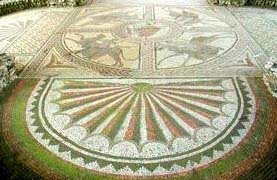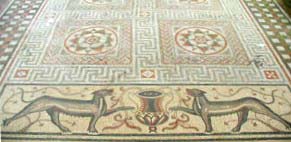Littlecote House Through the Ages
by Lisa Agnew
At the north-eastern edge of Wiltshire, bordering the county of
Berkshire beside the River Kennet, sits historic Littlecote
House, a Grade I listed building and now a hotel, although by no
means your average run-of-the-mill generic accommodation.
In its day, it has played host to such regal personages as Henry
VIII and his third par amour, Jane Seymour, his progeny Elizabeth
I, and later, Charles II. Yet before the great house had even
been built, these grounds were utilised by a particularly
imaginative Roman architect who oversaw the building (or perhaps
the refurbishment) of a unique Roman villa.
Initially, construction on the site began as a small military
establishment set up to guard a ford across the River Kennet.
From there, it evolved into farming huts and, from around 120 AD,
was converted into a villa-type building. For a time, activities
still revolved around farming and its associated traditions, work
which incorporated baking ovens, malting tanks and grinding
stones. After another fifty years or so, this building was
replaced by a large two-storey winged corridor villa with an
integral bath suite.
 The
site continued to go through a number of changes over the next
few centuries, notably a major rebuilding around 270 AD. After
another hundred years, agricultural activity ended and the
complex acquired a distinctly religious bent. A large barn was
converted into a courtyard and a very early triconch (a square
space with three semicircular extensions, usually found as throne
rooms in Roman or, more usually, Byzantine palaces) hall was
built alongside with its own bath suite. The
site continued to go through a number of changes over the next
few centuries, notably a major rebuilding around 270 AD. After
another hundred years, agricultural activity ended and the
complex acquired a distinctly religious bent. A large barn was
converted into a courtyard and a very early triconch (a square
space with three semicircular extensions, usually found as throne
rooms in Roman or, more usually, Byzantine palaces) hall was
built alongside with its own bath suite.
Rediscovered in 1730 when the now-famous Orpheus Mosaic and a
coin hoard, supposedly containing coins of emperor Vespasian (AD
69-79), was found, the area was only excavated from 1978 onward.
Now it is the only fully exposed villa compound in Britain and
has metamorphasised into a site of some controversy amongst
archaeologists. The controversy centres around the interpretation
of its now restored mosaic of the divine musician Orpheus,
considered by many archaeologists to be covering the floor of a
ritual chamber associated with the cult of Bacchus, the
pre-eminent pagan god of the Romans in post Biblical times. The
building, still labelled a villa despite this argument, does
indeed resemble the form of later, Christianised, Byzantine
churches. Other aspects of the architecture are also suggestive
of an architect working on refurbishment of the building in the
4th century AD, when it may have been converted to accommodate
visiting pilgrims. Many of the buildings seem to have been
demolished or fallen into decay by around 400 AD -- corresponding
with the beginning of the British Dark Ages and a prolonged
period of inter-tribal fighting.
There is an especially massive gatehouse to the site -- the
largest yet found on any villa in Britain. A display of material
and artefacts from the excavations can be found within Littlecote
House, which is in possession of its own enigmatic history. The
estate includes 34 hectares of historic parklands and gardens,
including a magnificent walled garden dating from the 17th
century. However, the most harrowing incident to happen within
the house and its grounds may be no more than legend.
 In 1575, the owner of Littlecote House was one William
Darrell, known as 'Wild Darrell'. It is said that a local midwife
was blindfolded and taken to the house by cover of night to
deliver a babe. Upon its birth, the poor thing was dashed into
the fireplace by the resident gent, and the midwife was
handsomely paid to keep her mouth shut. It seems that she did
not abide by the conditions of the bribe, and Wild Darrell was
brought to trial for the murder of the babe, whose mother turned
out to be Darrell's own sister. However, he managed to bribe the
judge and got off scot free, only to die shortly thereafter in a
hunting accident, when the ghost of the murdered baby appeared
before him, startling his horse and preventing him from jumping a
stile. The place where the stile stood is still known as
'Darrell's Stile'. In 1575, the owner of Littlecote House was one William
Darrell, known as 'Wild Darrell'. It is said that a local midwife
was blindfolded and taken to the house by cover of night to
deliver a babe. Upon its birth, the poor thing was dashed into
the fireplace by the resident gent, and the midwife was
handsomely paid to keep her mouth shut. It seems that she did
not abide by the conditions of the bribe, and Wild Darrell was
brought to trial for the murder of the babe, whose mother turned
out to be Darrell's own sister. However, he managed to bribe the
judge and got off scot free, only to die shortly thereafter in a
hunting accident, when the ghost of the murdered baby appeared
before him, startling his horse and preventing him from jumping a
stile. The place where the stile stood is still known as
'Darrell's Stile'.
All the above is not fully backed up by history, but lends
Littlecote House a suitably spooky aura, as the place is said to
be haunted by various apparitions from that era, including the
voice of a crying baby, the appearance of mysterious bloodstains
in the chamber where the crime took place and the twisted body of
murderer, Wild Darrell, still prowling the corridors.
The hotel cashes in on all this history and plays host to a
medieval banquet in its Great Hall, with tabards, hearty
mediaeval food and good cheer every Wednesday and Sunday.
£25 per person. Call +44 (0) 1488 682 509 for details.
To reach Littlecote House in the midst of the North Wessex Downs
Area of Outstanding Natural Beauty, exit the M4 motorway at
Junction 14 and take the A338 to the village of Hungerford. After
approximately 3 miles turn right onto the A4 (Hungerford to
Marlborough road) and, at the next roundabout, take the first
exit to follow the A4. Shortly afterwards turn right onto the
B4192 signposted to Littlecote House. After approximately one
mile the road bends sharply to the right. Take the small road
straight ahead and the entrance to Littlecote House is
approximately .5 mile on the right hand side. The grounds, and
the remains of the Roman villa, are open to the public.
More Information:
We regret that we no longer have the resources to maintain up-to-date links and/or hours and pricing details for the various sites and attractions listed on this website. For more information about the location(s) listed above, please use your favorite search engine or visit Wikipedia.
Lisa Agnew is a freelance writer of articles and speculative fiction. She is based in Auckland, New Zealand. English by birth, she harbours a life-long fascination with the history and folklore of her native land.
Article and photos © 2007 Lisa Agnew
|
